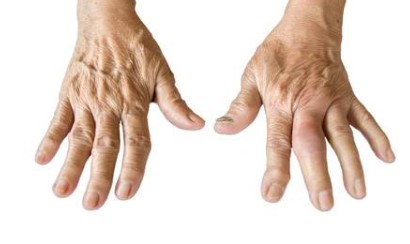
What is Osteoarthritis of the Hand and Thumb?
The term ‘arthritis’ is used to describe pain and swelling in a joint(s). There are many different types of arthritis, osteoarthritis being the most common; it is also known as ‘wear and tear’ arthritis as a result of the normal ageing process. Osteoarthritis can also be genetic or occur as a result of injury to a joint; this is known as ‘secondary osteoarthritis’.
Normal joints are constantly undergoing repair due to the daily wear and tear that is placed on them. In osteoarthritis this process does not seem to occur correctly and changes occur. The cartilage that covers the end of the bone becomes damaged and bony growths can form around the joint edges. These are called osteophytes and the tissues surrounding the joint can become inflamed which may lead to stiffness.

Diagram 1: Changes that occur in the hand with osteoarthritis.
Why does it occur?
It isn’t always clear but there are a number of factors that can play a role in developing OA of the hand, wrist and/or thumb, including:
- Age: OA is more common with increasing age. This is due to the natural wear and tear process and a reduction in the body’s ability to repair as you get older.
- Genetics: There is thought to be a link to inheriting OA.
- Gender: Women are more likely to develop OA than men.
- Previous injury: If you have had previous trauma or injury to your wrist thumb or a small joint in your hand this may contribute to OA.
- Care of the joint: Without periods of rest or looking after your joint(s) this can contribute to a flare up of your pain.
What is the natural history?
The term natural history is used to describe what happens when nature runs its own course. With osteoarthritis in the hand, it is often possible to see what is likely to happen with time by looking at the hands of parents, since this is often a hereditary condition. Most people will find that although their parents may have quite stiff and misshapen hands, their hands still work fairly normally and there is not much that they are unable to do because of the arthritis.
The majority of people develop osteoarthritic changes with time. For most the condition is not painful, although individual joints can occasionally become sore. This is as a result of inflammation of the joint which then produces pain. The inflamed and painful joint can last a few months to a few years, but usually ‘burns out’ with time. This ‘burn out’ means that the inflammation and pain eventually settles, although the joint is often quite stiff and sometimes deformed by this stage.
People who have a strong family history of osteoarthritis tend to report that single joints flare intermittently, and the process moves onto another joint when the arthritis burns out of one. Rarely, an individual can have a severe form of osteoarthritis, meaning that some, or all, of the joints flare at once. This usually runs in the family and the accompanying pain and inflammation can be severe. As the condition progresses the hands tend to become stiffer, which can result in difficulty when making a fist and fully straightening it back out.
How is it diagnosed?
We usually diagnose Osteoarthritis of the hand by your age, history and the symptoms you describe.
A clinical examination of your hand(s) is also helpful as sometimes Heberden’s and Bouchard nodes can be seen. These are bony lumps arising from the interphalangeal joints (small joints in your fingers).
The metacarpo-phalangeal joints (your large knuckles) are often spared. An x-ray will usually confirm the diagnosis however, if there is a possibility it may be a different form of arthritis, other than Osteoarthritis, then a blood test may be recommended.

What are the symptoms of Osteoarthritis of the wrist, hand and/or thumb?
The symptoms can include:
- Pain or discomfort.
- Stiffness or loss of movement.
- Weakness in your ability to grip or hold objects and difficulty performing finer tasks like buttons and zips.
- The joints can become swollen or misshapen and the knuckles can appear thicker.
Sometimes people can have no symptoms of this condition for a long time although X-rays can show changes. The opposite can also be true, with an individual having minor changes on an X-ray but severe symptoms.
Click HERE for a printable version of this section
Myths v Facts
OA of the wrist and hand
Myth 1 If my hands are painful now, will they be much worse unless something is done now?
Fact 1 Although slow deterioration usually occurs with Osteoarthritis, generally speaking pain ‘burns out’ with time, and the chances of symptoms being much worse in a year or two are slim.
Myth 2 If it is painful to use my hands, I will do more harm by continuing to use them.
Fact 2 Actually, there is no harm in using arthritic hands as normally as possible. Normal use of the hand does not cause the condition to worsen. Ageing and genetics are responsible for the rate of deterioration.
OA of the base of thumb
Myth 1 My pain will only get worse with time.
Fact 1 A diagnosis of OA of the thumb does not mean that it will continue to get worse. Only 25% (one in four) of patients deteriorate with this condition, 25% (one in four) improve and the remainder stay about the same.
Myth 2 Everyone with OA of the thumb needs an operation.
Fact 2 Symptoms of OA of the thumb can settle on their own. Some cases require simple treatment or advice and then settle. If your symptoms do not settle with simple treatment or advice there are other treatments that are available however not everybody will require these treatments.
Click HERE for a printable version of this section